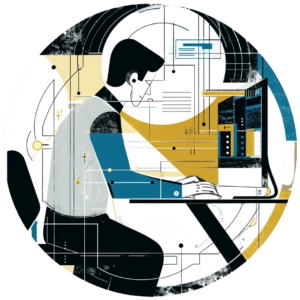In the healthcare ecosystem, one aspect that has undergone a remarkable transformation is the way medical bills are processed and submitted. Gone are the days when mountains of paper claims and endless filing cabinets were the norm. Instead, healthcare providers have embraced the power of electronic medical billing systems, revolutionizing the revenue cycle management process and paving the way for greater efficiency, accuracy, and cost-effectiveness.

At the heart of this digital revolution lies the desire to simplify a traditionally complex and time-consuming task. The manual processing of medical claims was fraught with challenges, from deciphering illegible handwriting to tracking down missing information and navigating the intricate maze of insurance policies and regulations. These hurdles not only created unnecessary delays but also increased the risk of errors, which could lead to costly claim rejections and dissatisfied patients.
Enter electronic medical billing, a game-changer that has reshaped the way healthcare providers manage their financial operations. Through harnessing the power of technology, this innovative approach has streamlined the entire billing process, enabling healthcare organizations to keep pace with the ever-increasing demands of the industry while providing better service to their patients.
The Journey to Automation
The journey toward electronic medical billing began with the recognition that paper-based processes were no longer sustainable in an era of rapid technological advancements. As healthcare costs continued to rise and the industry became more complex, the need for a more efficient and accurate billing system became increasingly apparent.
Early adopters of electronic medical billing systems quickly realized the numerous benefits this transition offered. Instead of manually filling out forms and mailing physical claims, healthcare providers could now submit claims electronically, reducing the risk of errors and ensuring timely processing. This not only improved cash flow but also freed up valuable resources that could be redirected towards patient care.
Robotic Process Automation (RPA) is a technology that enables the automation of repetitive, rule-based tasks by using software robots or virtual assistants. These software robots can mimic human actions and interact with various applications and systems, such as websites, databases, and enterprise software, to perform tasks with speed, accuracy, and consistency. RPA is designed to streamline and optimize business processes, reduce manual efforts, and improve operational efficiency. When automating mundane and time-consuming tasks, RPA allows organizations to reallocate human resources to more strategic and value-added activities, ultimately increasing productivity and reducing costs.
The Evolution of Electronic Medical Billing Systems
As with any technological advancement, electronic medical billing systems have undergone continuous refinement and evolution. What began as simple software programs for submitting claims has now blossomed into comprehensive platforms that encompass the entire revenue cycle management process.
Modern electronic medical billing systems are designed to seamlessly integrate with electronic health record (EHR) systems, allowing for a seamless flow of patient data from the point of care to the billing department. This integration eliminates the need for manual data entry, reducing the potential for errors and ensuring consistent information across all touchpoints.
Furthermore, these advanced systems offer robust reporting and analytics capabilities, providing healthcare organizations with valuable insights into their financial performance. From tracking claim status and identifying revenue leakage to optimizing coding practices and monitoring payer reimbursement trends, electronic medical billing systems empower providers with the data-driven intelligence necessary to make informed decisions and maximize revenue.
The Benefits of Going Digital
The adoption of electronic medical billing has brought about a multitude of benefits for healthcare providers, payers, and patients alike.
Here are some of the most notable advantages:
Increased Efficiency and Productivity
By automating many of the manual tasks associated with medical billing, electronic systems have significantly improved operational efficiency. Healthcare organizations can process a larger volume of claims in a shorter time frame, reducing administrative burdens and enabling staff to focus on higher-value activities.
Improved Accuracy and Compliance
Electronic medical billing systems incorporate built-in checks and validations to ensure compliance with coding standards and payer requirements. This not only reduces the risk of claim rejections but also helps prevent costly errors and potential penalties associated with non-compliance.
Faster Reimbursement Cycles
When claims are submitted electronically, they can be processed and adjudicated more quickly by payers. This accelerated turnaround time translates into faster reimbursement for healthcare providers, improving cash flow and financial stability.
Enhanced Data Security and Privacy
With electronic medical billing systems, sensitive patient and financial data is securely stored and transmitted, adhering to stringent industry standards and regulations such as HIPAA. This ensures the protection of confidential information and helps maintain patient trust.
Better Patient Experience
By streamlining the billing process and reducing the potential for errors, electronic medical billing systems contribute to a more positive patient experience. Patients receive accurate and timely bills, minimizing frustration and improving overall satisfaction with the healthcare provider.
Overcoming Challenges and Embracing Change
Despite the numerous benefits, the transition to electronic medical billing has not been without its challenges. One of the primary hurdles faced by healthcare organizations is the initial investment required to implement and integrate these systems. From purchasing the necessary hardware and software to training staff and ensuring compliance with industry regulations, the upfront costs can be substantial.
Additionally, the adoption of new technology often comes with a learning curve. Healthcare staff must adapt to new workflows and processes, which can initially lead to temporary dips in productivity and efficiency. Effective change management strategies and comprehensive training programs are crucial to mitigating these challenges and ensuring a smooth transition.
Furthermore, the ever-changing landscape of healthcare regulations and payer requirements necessitates continuous system updates and adaptations. Electronic medical billing systems must be flexible and scalable to accommodate these changes, requiring healthcare organizations to invest in ongoing maintenance and support.
Despite these challenges, the benefits of electronic medical billing far outweigh the hurdles. As more healthcare providers embrace this digital transformation, the industry as a whole is poised to reap the rewards of increased efficiency, improved financial performance, and enhanced patient satisfaction.
The Future of Medical Billing: Innovation and Integration
Looking ahead, the future of medical billing is inextricably linked to the continued advancement of technology and the integration of different healthcare systems. As electronic medical billing systems become more sophisticated, they will likely incorporate advanced analytics and artificial intelligence capabilities to further streamline the revenue cycle management process.
Predictive analytics and machine learning algorithms could be used to identify potential claim rejections or underpayments, enabling proactive interventions and optimizing reimbursement rates. Additionally, natural language processing could automate the coding process, reducing the risk of human error and ensuring accurate billing.
Moreover, the integration of electronic medical billing systems with other healthcare technologies, such as telemedicine platforms and remote patient monitoring devices, will become increasingly important. As the delivery of healthcare services continues to evolve and incorporate more virtual and remote components, billing systems must adapt to capture and process these new revenue streams effectively.
Furthermore, the rise of value-based care models and alternative payment methodologies will necessitate changes in how medical billing is approached. Instead of traditional fee-for-service billing, healthcare providers may need to adopt bundled payment models or capitated payment structures, requiring electronic medical billing systems to accommodate these new reimbursement paradigms.
Embracing a Paperless Future
As the healthcare industry continues its digital transformation, the future of medical billing is undoubtedly paperless. Electronic medical billing systems have proven their worth, streamlining processes, improving accuracy, and enhancing financial performance for healthcare providers.
While the transition to electronic billing may have seemed daunting initially, the benefits have been substantial, enabling healthcare organizations to focus on their core mission of delivering high-quality patient care. Healthcare providers are poised to navigate the complexities of the industry with greater agility and efficiency, ultimately contributing to a more sustainable and patient-centric healthcare system.

